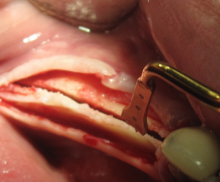Ridge splitting
|

The application of a bone substitute material like maxresorb® can help prevent the formation of soft tissue in between the cortical plates. Compared to bovine bone, the biphasic synthetic maxresorb® granules offer the advantage of a complete resorption as they are replaced by the patient's own bone in 2–3 years. In addition, a lateral application of the grafting material can improve the stabilization of the bone splitting.
Furthermore, the use of a membrane, such as the Jason® membrane or collprotect® membrane, to cover the augmentation site is recommended to ensure an undisturbed osseous regeneration. Particularly in the case of a thin biotype, the low thickness of the Jason® membrane facilitates the tension-free closure of the flap over the grafting site.
The expansion of the ridge requires a sufficient flexibility of the bone lamellae. Therefore, this technique is only indicated in the case of a moderate reconstructive need (inside contour <8 mm, outside <4 mm to augment) and minimal ridge width of 2–3 mm; this ensures the presence of cancellous bone between the lamellar plates. The suitable time point of implantation (e.g., whether performed in a one-stage procedure or following a proper amount of healing time) depends on the stability of the expanded segment and the residual bone volume.
Please Contact us for Literature.




















